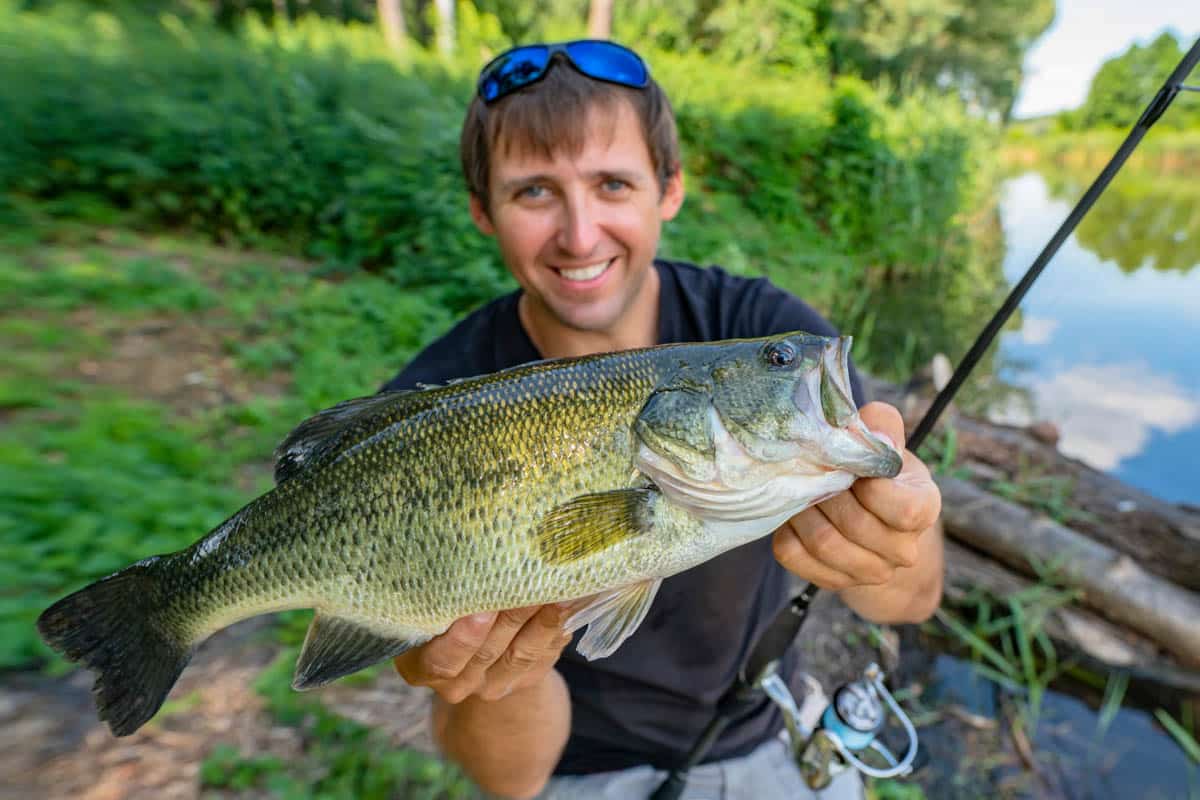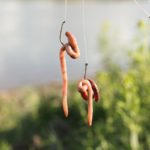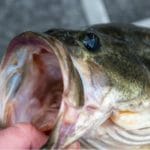If you’ve ever fished for bass or even looked into bass fishing, it’s likely that you’ve stumbled into the world of tube fishing. Tube fishing is its own particular style of fishing that mimics a small bait fish or a crawfish to lure bass or other fish to your hook.
To effectively fish a tube jig, start by casting it out and allowing it to sink naturally. Once it’s settled on the bottom, produce a series of hops and snaps to mimic the movement of a swimming fish. Remember to pause sporadically to entice strikes. It is important to adapt your technique based on fish activity levels and environmental conditions for optimal results.
When used correctly, tube fishing can be highly successful and can easily bring in some of the largest bass fish you can find.
Knowing how to fish a tube jig allows you to bring bass home almost any time of the year. There’s always a time and a place for tube fishing. In tube fishing, the rigging, different lines, baits, and technique are all important to getting your style down right. Here, we’ll go over how to fish a tube jig from the very beginning, all the way to the very end.
DISCLOSURE: As an Amazon Associate I earn from qualifying purchases. Many links in this article are affiliate links. If you click on a link we may earn a commission if you make a purchase, at no additional cost to you.
What is a Tube Jig for Fishing?
Bass love to live in waters of all different types. When they’ve decided to swim in choppy waters, a tube jig comes in handy.
A tube jig is designed to mimic a small baitfish or crawfish, and with the motion of the water, the tail of the tube will move and imitate the motion of the fish.
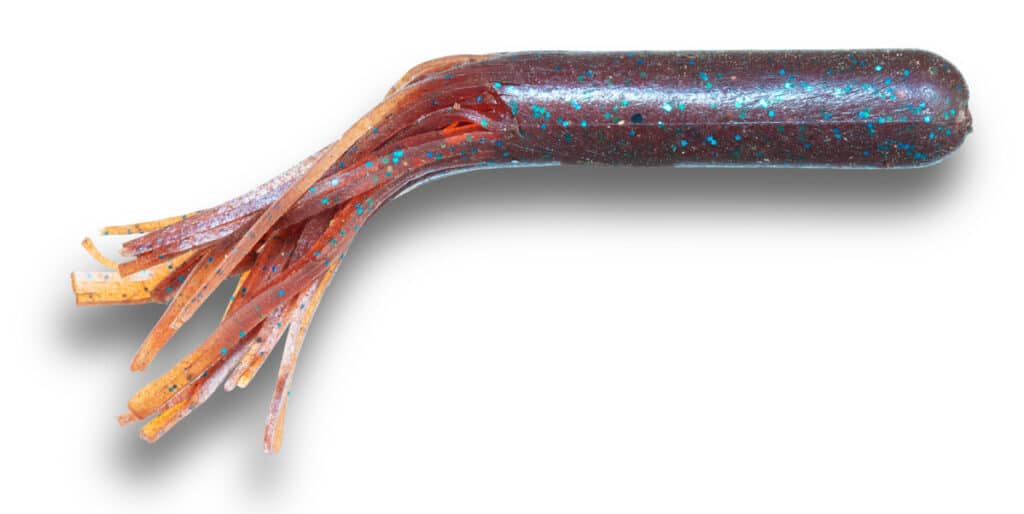
These tube jigs come in all different sizes and colors, but the basic premise is always the same. Tubes are a simple design, a small silicon tube with multiple tails coming off of it. The hollow of the tube works for simple rigging of a hook. Overall, it’s a simple, but highly functional design.
In combination with the tube, a weight is used to jig the tube through the water and create an accurate representation of the bait you’re attempting to replicate.
These tubes are best for fishing bass, as they most easily replicate the baitfish and crawfish that bass famously love to eat. You can adjust the tube for the time of year and location you’re in, making it possible to land all types of bass with different tube jigs.
What are Tube Jigs good for?
As mentioned, tube fishing is best for fishing bass. The tube can easily imitate a shad, crawfish, or golden shiner, all favorites of many bass species. The tube jig comes in handy when the water is turbulent from the weather or the general motion of the water itself. The tube will dance and the tail will move in the water, just like a fish.
Compared to classic baits, a tube falls through the water in a highly particular way that is hard to replicate with anything else. It’s a highly unique bait when used correctly, allowing for some incredible fishing.
Tube jigs are also a great way to introduce bass fishing to anyone just starting to learn how to fish. They’re incredibly forgiving and easy to fish, plus it’s a great way to learn how to study different bass, where they live, and what they like to eat.
Tubes come in all shapes and sizes, which also allows for a highly dynamic and diverse style of fishing. Plus, tube fishing has declined in its popularity over the years, making the tube even more efficient as bass are unaccustomed to their presence in the water.
Tube fishing falls amongst popular styles of fishing, which is to your benefit!
When to Fish With Tube Jigs
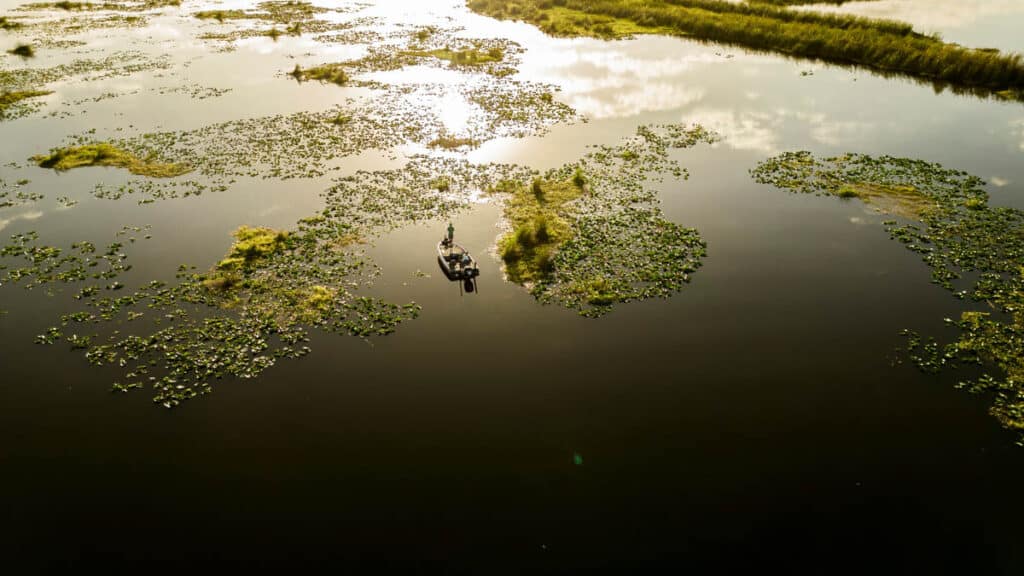
Knowing how to fish a tube jig is as much about knowing when to rig a tube as it is about knowing what tube to rig. There’s a diverse array of times in which fishing tubes for bass is the right move, but it isn’t a one-shot wonder that will do it all.
There are certain times when fishing a tube is the best choice by far:
- When water is choppy (Winter and Spring Seasons)
- When fishing rocky underwater terrain
- When fishing areas with several different bass species
- When fishing near docks
- When fishing thick weed mats where bass hang out
That being said, you can fish a tube jig any time you’re out on a lake, big water with sandy bottoms or large rocks, main lake dams, weed mats, and even around docks. When the right tube is used, you can fish them just about anywhere you want.
How to Rig a Tube Jig
There are plenty of different ways to rig a tube jig. Some of the methods are perfect for snapping along the bottom of sandy lakes, while others are better fit for weed mats or large rocky bottoms. Sometimes it’s best to rig up a few rods with different setups, just to have the option available.
A tube jig looks similar to a normal jig, but typically has a longer piece of lead and the eyelet is always different. The eyelet sticks out away from the hook so that it can be stuck through the front of the tube.
To rig a classic tube jig, simply shove the weight up from the bottom of the tube to weigh the top half of the tube. Then push the eyelet through the front of the tube so that the hook sticks out the bottom with the eyelet at the top.
This setup leaves you with an exposed hook, which can be difficult for heavy vegetation or dense rocky bottoms.
Texas Rig
A Texas rig is perfect for any time you want to fish a tube in a weed mat. With an EWG (extreme wide gap) hook, you have plenty of space to shove the tube back on the hook and expose just enough to help snag the fish.
You can also use a Texas rig when dragging along the bottom of any body of water in order to avoid the hook snagging on something that isn’t the bass you’re after.
Drop Shot Rig
Using a small tube on a drop shot is a great way to fish a tube in large rocky areas. The sinker will hold the tube in place while you jig it around and lure a bass out of its hiding in the rocks.
Not only does this setup help bring in bass, but it will also help you to avoid fraying your line. Even when the sinker gets trapped, you won’t lose the tube or the hook.
Punch Rig
Finally, a classic punch rig setup will work well with tubes as well. This is a great choice when fishing heavy weed mats, often catching even less than when using a Texas rig. If a bass is in serious hiding, it can be tough to reach. This rig will make it significantly easier.
How to Fish a Tube Jig
Fishing a tube jig is a rather easy, forgiving style of fishing that makes it easy to learn and practice even if you don’t have a lot of experience. There are a lot of different techniques to learn and choose from, but just like all fishing techniques, everyone has their favorite.
To fish a tube jig in the most simple matter:
- Cast it out and allow the tube to fall to the bottom
- On the way down it will spiral like a skirt on a bass jig, and can often trigger a bite right away.
- Once the tube reaches the bottom, fish it like a regular jig, hopping and snapping along the bottom with quick, short motions. The goal is to move the jig up and down along the bottom to imitate a fish swimming along.
- In between the jerking and snapping, make sure you include a brief pause. This is when the bite is most likely to be triggered, rather than when in motion.
- Snapping the jig quickly can imitate a crawfish that is darting from one hiding spot to another, but not all fish are going after the quickest-moving bait.
- When fish are lethargic, typically in colder waters, you want to drag the tube slowly along the bottom rather than moving quickly. Sometimes a fish wants an easy target, rather than a difficult chase.
There are plenty of other methods of fishing a tube jig. When rigged up with a drop shot, you will jig the tube in one spot multiple times rather than moving around as much.
When skipping, you will keep your rod at a low angle, and use that low angle to pull the tube quickly across the bottom without much movement up and down.
Best Tube Fishing Gear

You can fish a tube with just about any spinning or baitcaster setup. But in my experience, some gear works better than others.
Related: Best Tube Fishing Rods
Reels for Fishing Tubes
In general, you can use either a baitcaster or a spinning reel when fishing tubes. This can often come down to personal preference, but you can also choose them depending on the style of tube you’re using.
A smaller tube will work better with a spinning reel as it gives you more finesse and control over the jigging motion to dance the tube through the water.
If skipping, a baitcaster will be much more difficult to use, but they come in handy with larger and heavier tubes. Many people prefer a baitcaster, but they are much more difficult to use as a beginner.
Pick what you feel the most comfortable with, as it’s likely what you’ll have the most success with.
Best Fishing Line for Tubes
The best fishing line for tubes can change depending on conditions. Typically, a heavier braided line allows you to cast smaller baits further and still reel in any size fish with ease. However, a heavier line can be much more visible when fishing in crystal clear waters, meaning you need to switch it up depending on where you are.
At the end of your line, use a fluorocarbon leader before rigging up the tube. Since tube fishing is a highly active process, you’ll want to protect your line from the abrasion that’s unavoidable when jigging around the bottom of the water. Fluorocarbon or floroclear are both great options for this.
What Hooks To Use With Tubes
The hook you use with your tube is going to change in regards to where you are fishing and the way you choose to rig up your line. You can use a classic tube jig, or an EWG hook sized correctly for the tube that you are using.
Tube Jig Sizes and Colors
Tubes are great because of their versatility and all the different sizes and colors that they come up with. Natural tones are often the best colors for winter whereas brighter, more vibrant colors like chartreuse and neons can be great in summer. In the fall use deep purples and reds as well as silver, gold, and pumpkin seed.
One of the best ways to choose what color and size tube you are wanting to use is to set one bass aside in a live catch and wait. Bass will typically spit something up if given the time. From this, you can decide what the fish are eating that time of year in the area you’re in.
It’s best to grab a wide variety of different sizes and colors in order to be prepared for any situation. Some 3.5” tubes are good for a lot of different bass, but you may want to pick up some longer and shorter ones for massive bass and finesse fishing.
How to Rig a Tube for Skipping
Bass love docks and skipping is a great way to fish for them in those areas. While you can fish shallow docks in a lot of different ways, skipping is a great way to get a lot of bass quickly. The main difference is just to use a lighter head jig with your tube in order to provide more finesse in your casting and skipping.
How to Fish a Tube for Bass
Tubes are known classically for their ability to catch smallmouth bass, but it works incredibly well for largemouth bass as well. This technique is focused on the bottom of the water, where bass tend to live.
Pro Tip: Snapping, jerking, and skipping are the most common techniques when going after bass, as the baitfish and crawfish bass love tend to move quickly from hiding spot to hiding spot.
The only thing that might change between fishing smallmouth and largemouth bass is going to be the tube that you choose. However, you can often catch a smallmouth and a largemouth with the exact same tube depending on where you’re at.
How to Fish a Tube Jig for Trout
Fishing a tube jig for trout can be highly effective, but is a much different technique than when fishing for bass. For trout, the tube acts like more of a trailer attached to a float.
Rig the tube a set distance (1-2 feet) down from a float and move it slowly along the water’s surface. Trout are much more likely to chase a baitfish higher in the water than down low like with a bass.
This is a great way to switch up how you fish with a tube and can expand the different fish you catch with them. Some people will even use this technique to catch salmon as well.
Final Thoughts on Fishing Tubes for Bass
Tube fishing is one of the most versatile styles of fishing out there. Not only can you use it to catch a wide array of bass, but you can also snag trout and salmon when changing up the technique. Fishing tubes for bass is a great way to get newcomers hooked on fishing with a technique that has a high success rate. It is quick to learn, forgiving, and a heck of a lot of fun!

